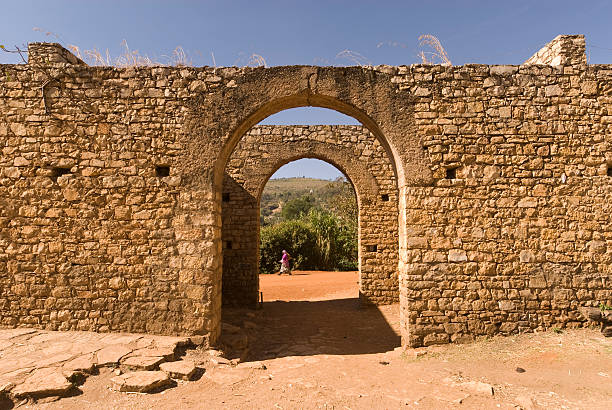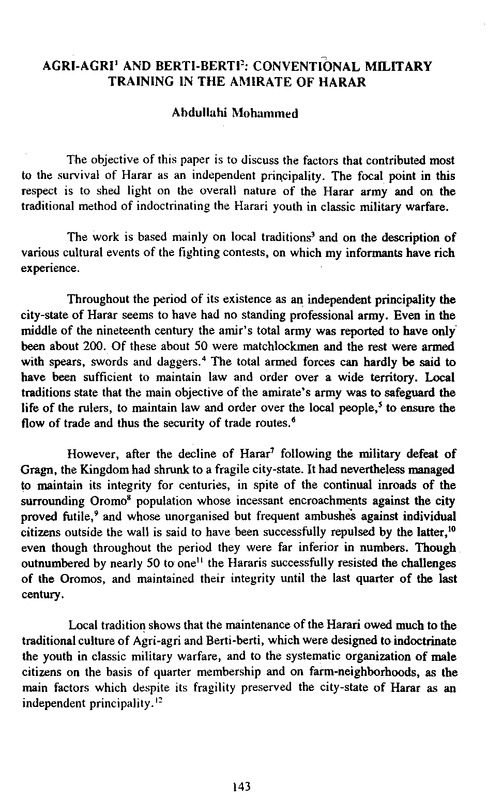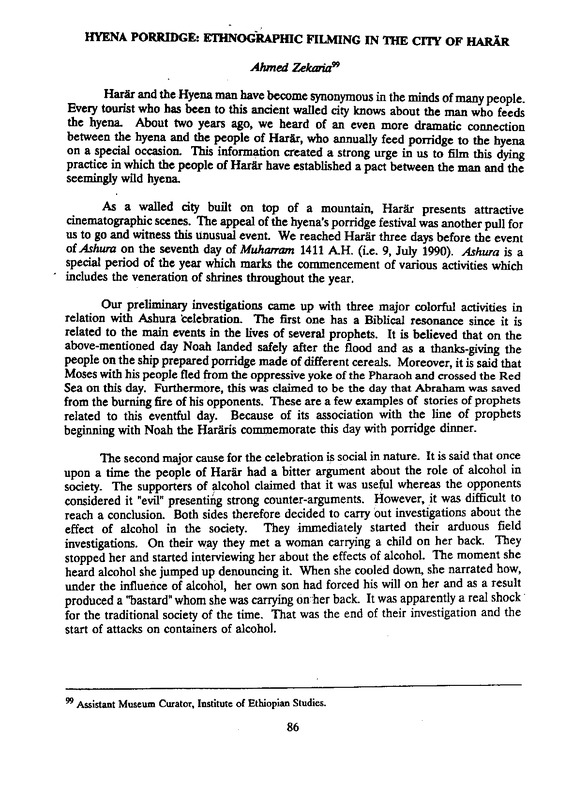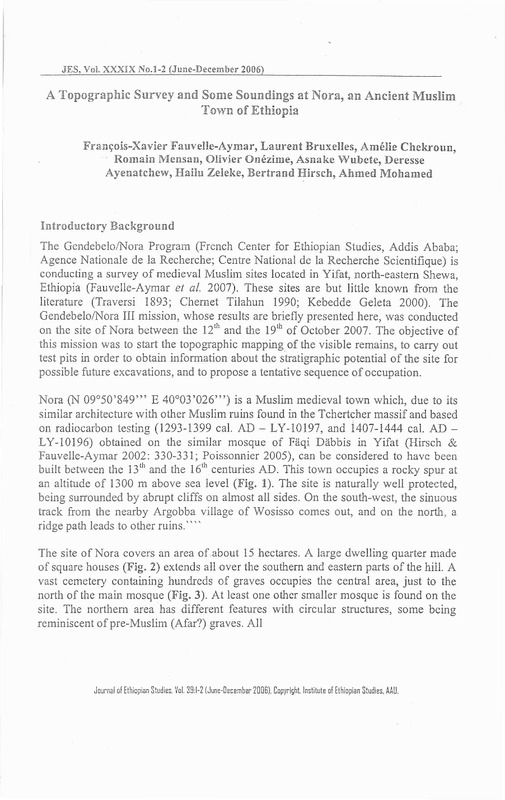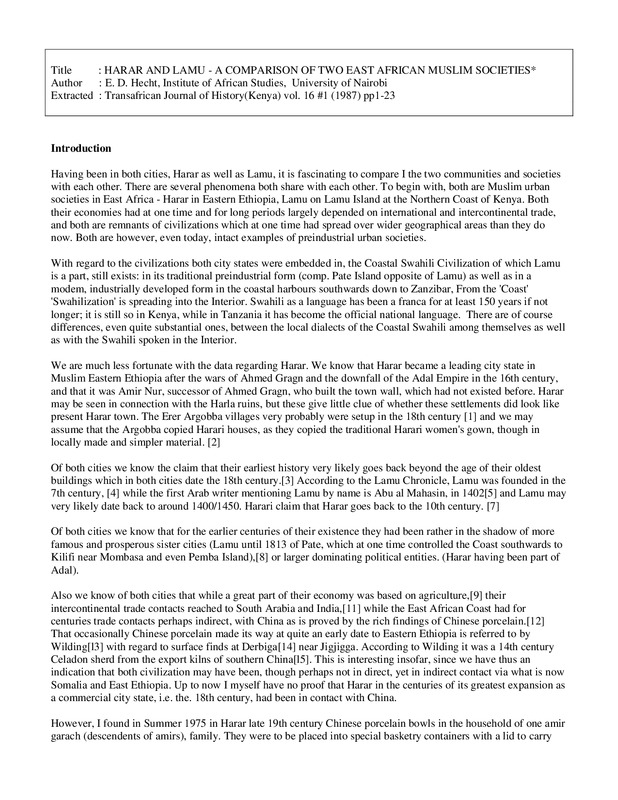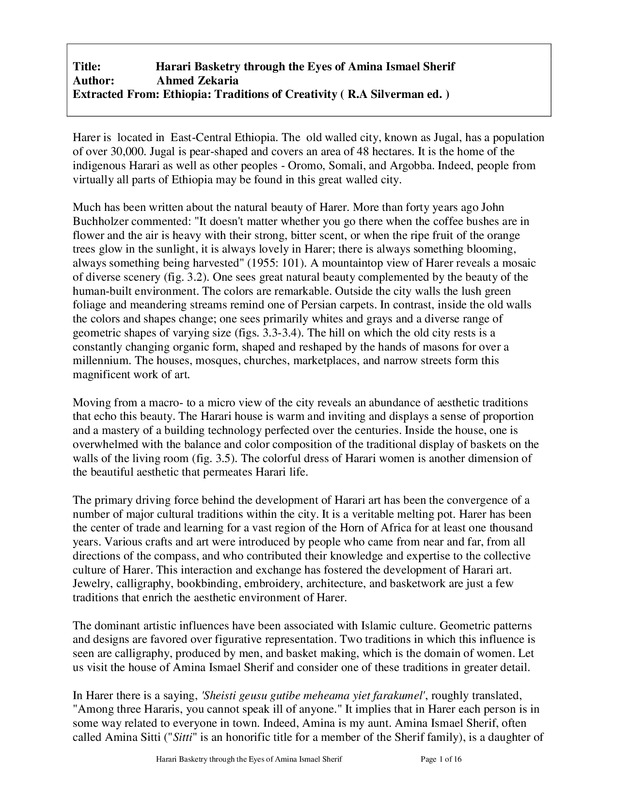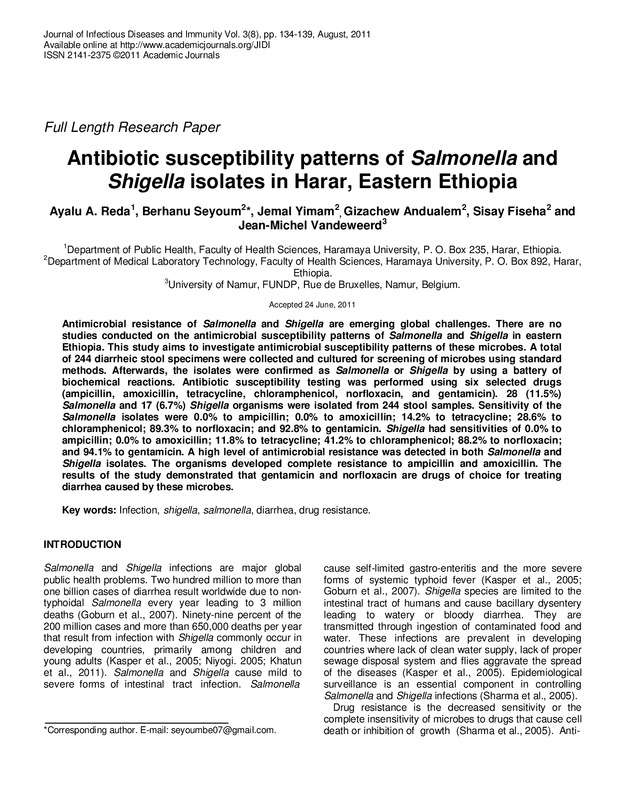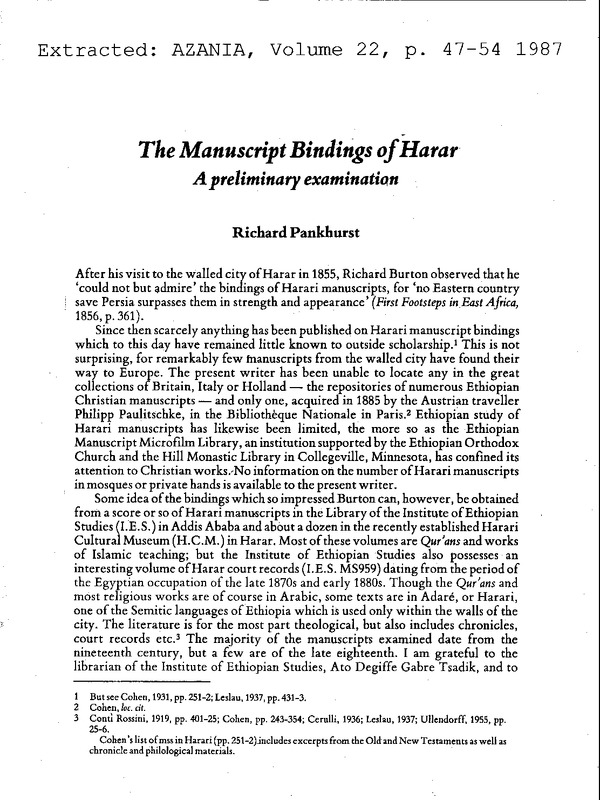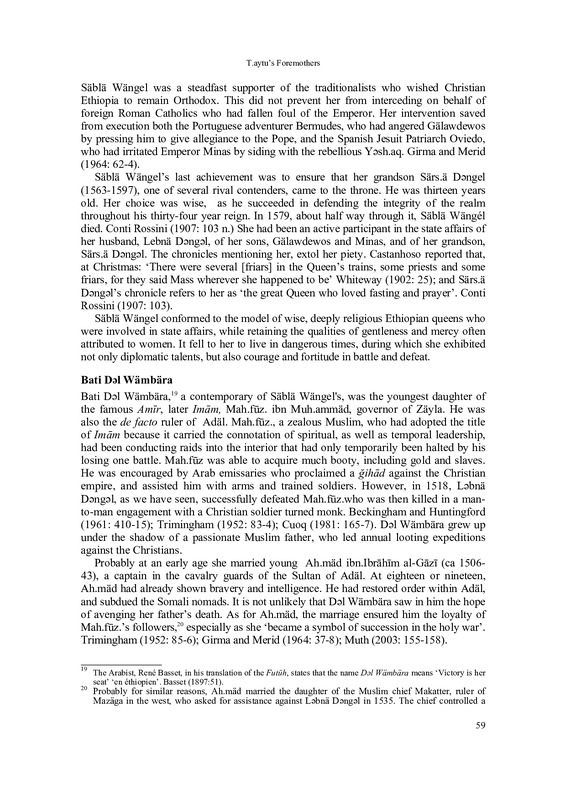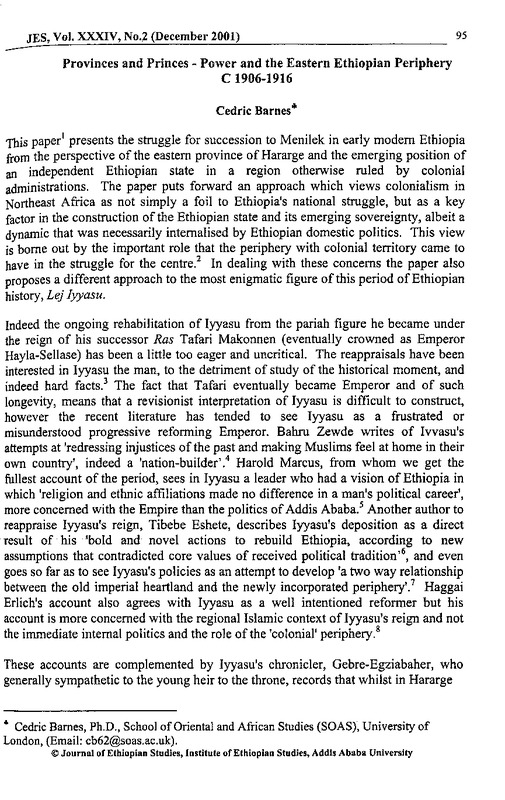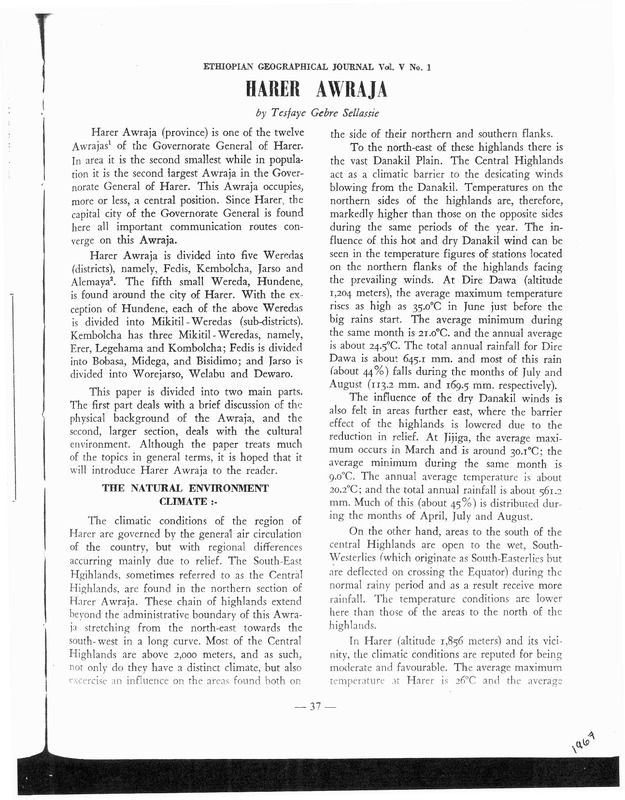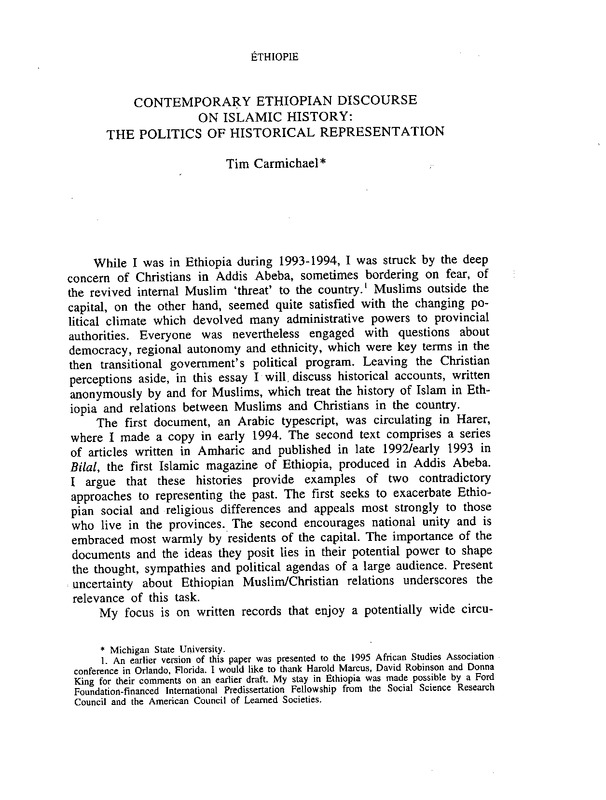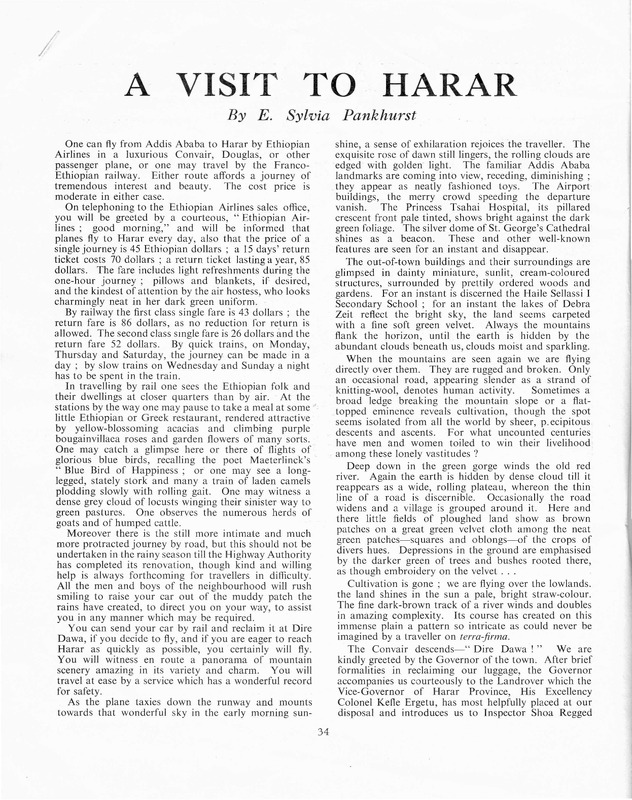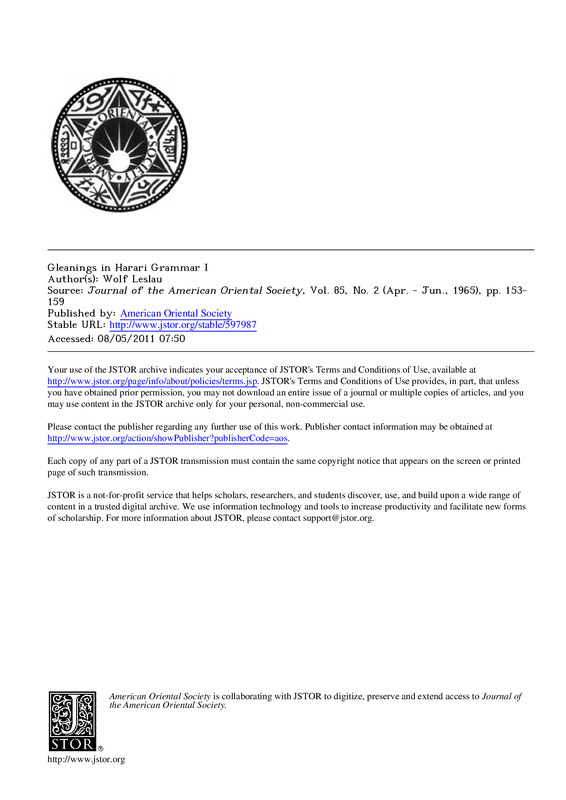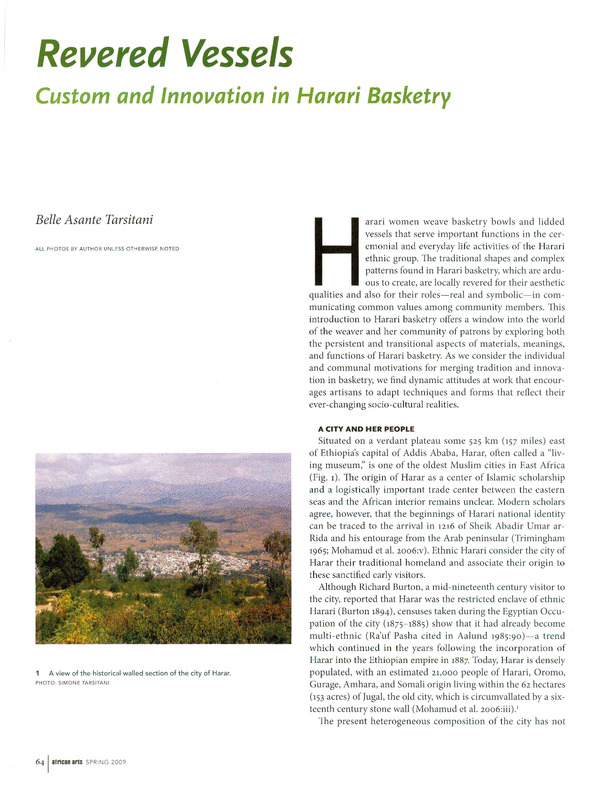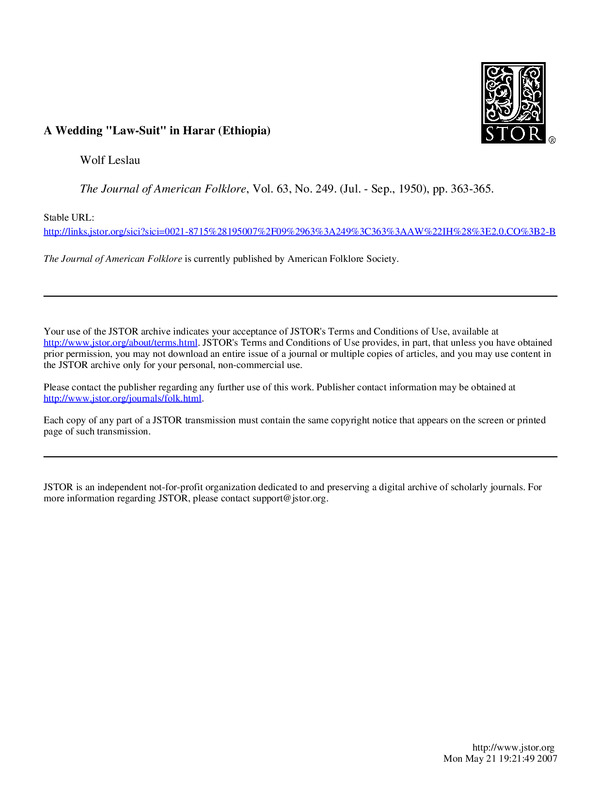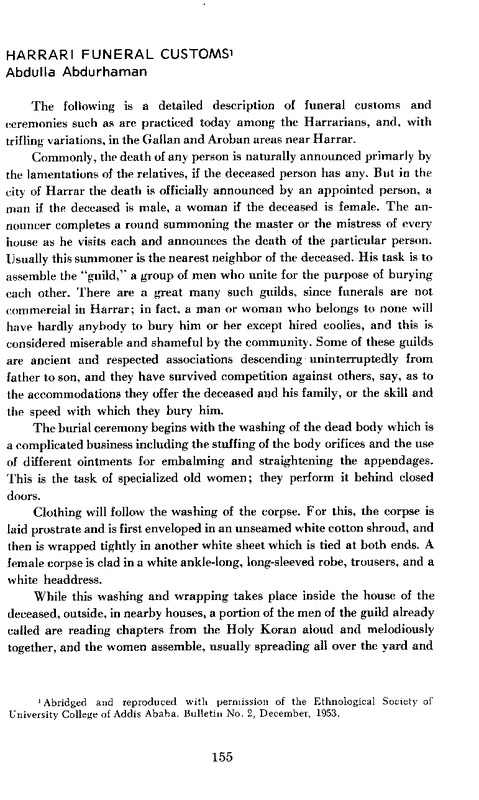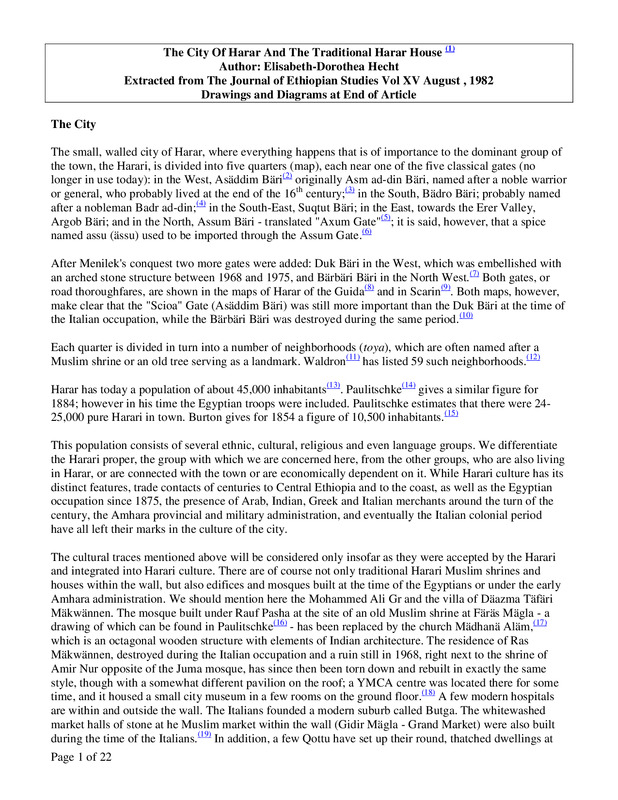Items
-
AGRI- AGRI AND BERTI-BERTI: CONVENTIONAL MILITARY TRAINING IN THE EMIRATE OF HARARDate:The objective of this paper is to discuss the factors that contributed most to the survival of Harar as an independent principality.
-
The Insect Pests of Vegetables In Harar ProvinceDate: 1965The cultivation of vegetables in Harar Province is carried out mostly in small mixed lots by native fanners.
-
HYENA PORRIOGE; ETHNOGRAPHIC FILMING IN THE CITY OF HARARDate:Harar and the Hyena man become synonymous in the minds of many people. Every tourist who has been to this ancient walled city knows about the man who feeds the hyena.
-
A Topographic Survey and Some Soundings at Nora, an Ancient MuslimDate: 2006Introductory BackgroundThe GendebelolNora Program (French Center for Ethiopian Studies, Addis Ababa;Agence Nationale de la Recherche; Centre National de la Recherche Scientifique) isconducting a survey of medieval Muslim sites located in Yifat, north-eastern Shewa,Ethiopia (Fauvelle-Aymar et al. 2007). These sites are but little known from theliterature (Traversi 1893; Chernet Tilahun 1990; Kebedde Geleta 2000). TheGendebelolNora III mission, whose results are briefly presented here, was conductedon the site of Nora between the ith and the 19th of October 2007. The objective ofthis mission was to start the topographic mapping of the visible remains, to carry outtest pits in order to obtain information about the stratigraphic potential of the site forpossible future excavations, and to propose a tentative sequence of occupation.Nora (N 09°50'849'" E 40°03'026''') is a Muslim medieval town which, due to itssimilar architecture with other Muslim ruins found in the Tchertcher massif and basedon radiocarbon testing (1293-1399 cal. AD - LY-10197, and 1407-1444 cal. AD -LY-10196) obtained on the similar mosque of Faqi Dabbis in Yifat (Hirsch &Fauvelle-Aymar 2002: 330-331; Poissonnier 2005), can be considered to have beenbuilt between the 13th and the 16th centuries AD. This town occupies a rocky spur atan altitude of 1300 m above sea level (Fig. 1). The site is naturally well protected,being surrounded by abrupt cliffs on almost all sides. On the south-west, the sinuoustrack from the nearby Argobba village of Wosisso comes out, and on the north, aridge path leads to other ruins.
-
HARAR AND LAMU - A COMPARISON OF TWO EAST AFRICAN MUSLIM SOCIETIESDate: 1987Having been in both cities, Harar as well as Lamu, it is fascinating to compare I the two communities and societies with each other. There are several phenomena both share with each other. To begin with, both are Muslim urban societies in East Africa - Harar in Eastern Ethiopia, Lamu on Lamu Island at the Northern Coast of Kenya. Both their economies had at one time and for long periods largely depended on international and intercontinental trade, and both are remnants of civilizations which at one time had spread over wider geographical areas than they do now. Both are however, even today, intact examples of preindustrial urban societies.
-
Harari Basketry through the Eyes of Amina Ismael SherifDate:Harer is located in East-Central Ethiopia. The old walled city, known as Jugal, has a population of over 30,000. Jugal is pear-shaped and covers an area of 48 hectares. It is the home of the indigenous Harari as well as other peoples - Oromo, Somali, and Argobba. Indeed, people from virtually all parts of Ethiopia may be found in this great walled city.Much has been written about the natural beauty of Harer. More than forty years ago John Buchholzer commented: "It doesn't matter whether you go there when the coffee bushes are in flower and the air is heavy with their strong, bitter scent, or when the ripe fruit of the orange trees glow in the sunlight, it is always lovely in Harer; there is always something blooming, always something being harvested" (1955: 101). A mountaintop view of Harer reveals a mosaic of diverse scenery (fig. 3.2). One sees great natural beauty complemented by the beauty of the human-built environment. The colors are remarkable. Outside the city walls the lush green foliage and meandering streams remind one of Persian carpets. In contrast, inside the old walls the colors and shapes change; one sees primarily whites and grays and a diverse range of geometric shapes of varying size (figs. 3.3-3.4). The hill on which the old city rests is a constantly changing organic form, shaped and reshaped by the hands of masons for over a millennium. The houses, mosques, churches, marketplaces, and narrow streets form this magnificent work of art.Moving from a macro- to a micro view of the city reveals an abundance of aesthetic traditions that echo this beauty. The Harari house is warm and inviting and displays a sense of proportion and a mastery of a building technology perfected over the centuries. Inside the house, one is overwhelmed with the balance and color composition of the traditional display of baskets on the walls of the living room (fig. 3.5). The colorful dress of Harari women is another dimension of the beautiful aesthetic that permeates Harari life.
-
PALAEONTOLOGY OF HARRAR PROVINCE, ETHIOPIADate: 1920 - 1921pt. 1. The Dudley Expedition / by Barnum Brown. The Harrar Plateau. Crystalline basement. The Adigrat sandstone. Upper Jurassic limestones. Cretaceous deposits. Nubian sandstone(?). Tertiary and Quaternary deposits. The Dirre Daua region. The Hargeisa, British Somaliland, region -- pt. 2. Echinoidea / by Ethel D. Currie. Jurassic Echinoidea from Ethiopia. Cretaceous Echinoidea from Ethiopia. Eocene Echinoidea from British Somaliland.
-
Antibiotic susceptibility patterns of Salmonella andDate: 2011The study was conducted in two of the four referral hospitalslocated in Harar, eastern Ethiopia. A convenience sample ofpatients who visited the adult outpatient departments of Hiwot Fanaand Misrak Arbegnoch teaching hospitals from January 2007 toFebruary 2007 for complaints of diarrheal disease was included inthe study. These hospitals were selected for the study because oftheir close affiliation to the Faculty of Health Sciences of HaramayaUniversity where the laboratory used for this study is located. Thepatient flow of the hospitals ranges from rural and urban dwellers toclients of diverse socioeconomic and ethnic backgrounds.
-
Different Names of Jugol 5 gatesDate:Abdulmuhaimin gives corresponding names for the Harar jugol gates in 4 different languages, Amharic, Oromo, Somali, and English,
-
BELEAGUERED MUSLIM FORTRESSES ANDDate: 2008J.S. Trimingham has famously described Ethiopia as a “beleaguered fortress in the midst of a sea of Islam,” implying Christians in Ethiopia have consistently been besieged by Muslims, not vice versa. This thesis challenges this common conception by demonstrating that throughout Ethiopia’s medieval period (1270-1555), the time of greatest conflict between the Ethiopian Empire and its Muslim neighbors, Muslim forces did not besiege the Ethiopian Empire. On the contrary, the Ethiopians militarily subjugated their neighboring Muslim sultanates, most prominently Ifat and Adal, and politically divided the sultanates’ ruling families to keep them weak. These tactics, designed to wrest control of trade from the sultanates, were resoundingly successful until Muslims unified around military/religious leaders, primary among them being Imam Gran, who in 1531 conquered the Ethiopian Empire. Though Imperial forces reversed the conquest by 1543, a historical focus on this event still feeds the misperception that Ethiopia’s history is that of a Christian kingdom ensconced in a fortress to protect itself from a beleaguering “Muslim menace.” This thesis concludes to the contrary that the Ethiopian Empire waded aggressively and purposefully into the sea of Islam to beleaguer its many Muslim neighbors.
-
DELWANBARADate:
-
Provinces and Princes - Power and the Eastern Ethiopian Periphery C 1906-1916Date: 2001This paperl presents the struggle for succession to Menilek in early modern Ethiopia from the perspective of the eastern province of Hararge and the emerging position of an independent Ethiopian state in a region otherwise ruled by colonial administrations. The paper puts forward an approach which views colonialism in Northeast Africa as not simply a foil to Ethiopia’s national struggle, but as a key factor in the construction of the Ethiopian state and its emerging sovereignty, albeit a dynamic that was necessarily internalised by Ethiopian domestic politics. This view is borne out by the important role that the periphery with colonial territory came to have in the struggle for the centre.2 In dealing with these concerns the paper also proposes a different approach to the most enigmatic figure of this period of Ethiopian history, Le} lyyasu………… ……Provincial Paralysis In 1906 Ras Makonnen 13 of Harar died. In the resource centred and frontier fuelled politics of the Ethiopian Empire Hararge province was second only to Shawa. Makonnen was one of the comparatively small coterie of closely related Shawans who had led the military expansion of the Shawan state and through his command of the Hararge gezat, he was the head of a whole section of interests and system of rule. His early death upset the careful equations of power on which Menilek’s patrimonial empire was constructed. A vacancy at the top of the pyramid of power opened up a wealth of possibilities for the use, acquisition, but also the deliquescence of power. Indeed affairs in the eastern province of Hararge after Makonnen’s death are an example of the problematic transfer of power in the nascent Ethiopian empire, even at provincial level, and anticipated the coming crisis at the centre.
-
HARER AWRAJADate: 1967
-
A VISIT TO HARARDate:
-
GLEANINGS IN HARARI GRAMMAR IDate: 1965THE LANGUAGE OF HARARI that is spoken inthe Moslem city of Hiarar is one of the Ethiopianlanguages for which no exhaustive grammar is inexistence. Preliminary studies were published byF. M. C. Mondon-Vidailhet, La langue harari etles dialectes ethiopiens du gouraghe, Paris, 1902,p. 1-75; and Marcel Cohen, Etudes d'ethiopienmeridional, Paris, 1931, p. 234-354. More completestudies were published by E. Cerulli, Studietiopici. I. Harari, Rome, 1931; and W. Leslau,The Verb in Harari, Berkeley and Los Angeles,1958.There are still many features in the morphologyand in the syntax that have not been adequatelyinvestigated because of insufficient number of texts.The only existing texts and phrases are thoseof E. Cerulli, op. cit. p. 204-228. I myself had
-
Gey Sinan Dadwa HifotDate: 2006Poetic description of Harari Language It's practice, the sweetness and lovely characteristics of it's use and application.Unpublished Book, made available to the public by the Author.
-
HARARI REGIONAL GOVERNMENT PEFADate: 2010SUMMARY OF ASSESSMENT 1. Integrated Assessment of PFM performance This section summarizes the detailed indicator led-assessment along the six core dimensions identified in the performance measurement framework. Table 1 summarizes the scoring. (a) Credibility of the budget (PIs 1- 4) As revealed by performance indicators 1-3, the budget was by and large implemented as planned except performance indicator 2. The significant deviation indicated by the composition of expenditure outturn compared to the original approved budget has highly contributed to weaken budget credibility. On the other hand due to tight internal control system, strict rules and regulations and strong culture of compliance, the stock of arrears was significantly low, below 2% for the EFY 2000 and 2001 while no arrears were reported in EFY 1999. (b) Comprehensiveness and Transparency The scores of performance indicators under the comprehensiveness and transparency reveal mixed results. The fairly good classification of the budget that allows tracking of expenditures and the insignificant level of unreported extra budgetary expenditures (with the exception of Global Fund expenditures) reveal very good comprehensiveness and transparency. On the other hand, the lack of comprehensiveness of information included in the budget documentation and the lack of access to key fiscal information signifies poor comprehensiveness and transparency. (c) Policy based budgeting The annual budget process is by and large conducted in an orderly way. There is a fixed budget calendar which allows sector bureaus/offices sufficient time to process their budget proposals in accordance with guidelines issued by BoFED. However, there are problems with the timely approval of the budget by the legislature. In addition, no multiyear fiscal forecast on a rolling annual basis has been introduced even though fixed multi-year sectoral development programs and strategic plans are operational. (d) Predictability and control in budget execution Taxes raised by the regional government have legal basis. The income tax is comprehensive and clear with tax payers having easy access to information on tax liabilities. A tax appeal system was setup. A cash flow system has been operational. Bureaus are able to commit expenditure within the year based on approved budget. Procurements are governed by proclamation and directives. However, there are no compiled data on the methods used to award public contracts. Internal audit is operational in the majority of the bureaus/offices but focus on transaction audits than systemic audit. There is lack of complete accounts reconciliation between tax assessment, collections, arrears records and receipts by treasury. Tax arrears are not recorded and no compiled information is available in this
-
Revered Vessel..Custom and innovation in Harari BasketryDate: 2009Basketworks of Harar including pictures.
-
A Wedding Law-SuitDate: 1950The text of the "law-suit" is formal and was given to me as follows.A =accuser, B =accused.A: "In the name of the bridegroom, in the name of the bride, in the name of theyoung man; if there are left (others that I don't mention), forgive me. As to the garad5Ahmad Addus, I ask for a verdict against him. When the young men played helaughed, indeed; I want you to inform yourself about i t (for me)." arriz sera, arrizitsera, darma sera; zipara bal gir, awfi iislufi. abmad addas garad-be hap i_ka3-b-ab-a._k
-
The City Of Harar And The Traditional Harar House (1)Date: 1982The CityThe small, walled city of Harar, where everything happens that is of importance to the dominant group of the town, the Harari, is divided into five quarters (map), each near one of the five classical gates (no longer in use today): in the West, Asäddim Bäri(2) originally Asm ad-din Bäri, named after a noble warrior or general, who probably lived at the end of the 16th century;(3) in the South, Bädro Bäri; probably named after a nobleman Badr ad-din;(4) in the South-East, Suqtut Bäri; in the East, towards the Erer Valley, Argob Bäri; and in the North, Assum Bäri - translated "Axum Gate"(5); it is said, however, that a spice named assu (ässu) used to be imported through the Assum Gate.(6)After Menilek's conquest two more gates were added: Duk Bäri in the West, which was embellished with an arched stone structure between 1968 and 1975, and Bärbäri Bäri in the North West.(7) Both gates, or road thoroughfares, are shown in the maps of Harar of the Guida(8) and in Scarin(9). Both maps, however, make clear that the "Scioa" Gate (Asäddim Bäri) was still more important than the Duk Bäri at the time of the Italian occupation, while the Bärbäri Bäri was destroyed during the same period.(10)Each quarter is divided in turn into a number of neighborhoods (toya), which are often named after a Muslim shrine or an old tree serving as a landmark. Waldron(11) has listed 59 such neighborhoods.(12)

